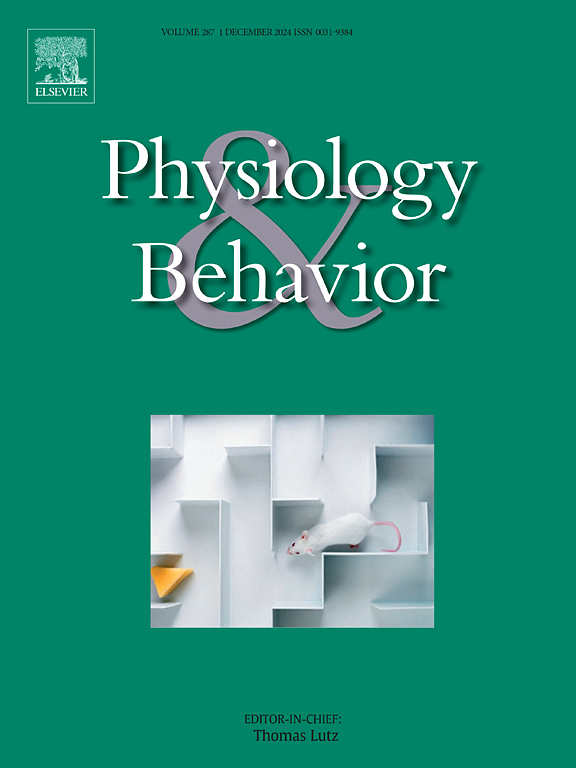Sex differences in motivation to take sucrose following abstinence and environmental enrichment in Long-Evans rats
IF 2.4
3区 医学
Q2 BEHAVIORAL SCIENCES
引用次数: 0
Abstract
There are clinically significant sex differences in addiction behaviors. We have previously reported robust sex differences in motivation to consume sucrose in adult Long-Evans rats. In the present study, motivation to consume 10 % sucrose was assessed with lever press responding (0.4 mL per reinforcement) on a progressive ratio (PR) schedule during daily 3-h sessions for 1 week following either overnight (acute) or 1 month (chronic) environmental enrichment (EE). Acute EE was provided immediately after initial training or after 29 days of abstinence. Males and females were segregated by sex throughout the study. Females responded to higher breakpoints during training and post-EE testing. In both sexes, there was an abstinence-dependent increase (incubation) of PR responding for sucrose in control subjects tested after 1 month vs. 1 day of abstinence. Both acute and chronic EE decreased subsequent breakpoints, but the persistence of the effect differed by sex and length of abstinence. For testing following 1 day of abstinence from sucrose, acute EE with males resulted in decreased breakpoints persisting 3 days. EE-induced reductions in breakpoints for females were not statistically significant. For testing starting after 29 days of abstinence from sucrose, acute EE with males resulted in decreased breakpoints persisting 3 days. Chronic EE with males decreased their breakpoints for 3 days but had no effect on responding by females. EE-induced reductions in breakpoints for females were not statistically significant. Sucrose consumption relative to body weight was reduced by EE for males similar to decreases in breakpoints. For females, acute (both early and late abstinence) and chronic EE also reduced sucrose consumption, but only on the first day of testing. These results replicate our previous findings of greater motivation to consume sucrose by females, demonstrate an incubation of PR responding for both sexes, and an overall more persistent anti-sucrose taking effect of EE with males.
Long-Evans大鼠戒糖和环境富集后服用蔗糖动机的性别差异。
在临床上,成瘾行为存在显著的性别差异。我们以前曾报道过成年龙-埃文斯大鼠在消耗蔗糖的动机上存在明显的性别差异。在本研究中,在连续1周的夜间(急性)或1个月(慢性)环境富集(EE)后,以渐进比率(PR)计划每天3小时的杠杆按压反应(每次强化0.4 mL)来评估消耗10%蔗糖的动机。急性情感表达是在初始训练后立即提供的,或在禁欲29天后提供的。在整个研究过程中,男性和女性按性别分开。女性在训练和情感表达后测试中有更高的断点。在两性中,对照受试者在禁欲1个月后与禁欲1天相比,对蔗糖的PR反应有戒断依赖性增加(潜伏期)。急性和慢性情感表达都降低了随后的断点,但效果的持久性因性别和禁欲时间长短而异。在禁食蔗糖1天后的测试中,男性急性EE导致断点下降持续3天。电子电气诱导的女性断点降低在统计学上不显著。在禁食29天后开始的测试中,男性急性EE导致断点下降持续3天。男性的慢性情感表达在3天内降低了他们的断点,但对女性的反应没有影响。电子电气诱导的女性断点降低在统计学上不显著。相对于体重的蔗糖消耗量被EE降低了,这与断点的降低相似。对于女性,急性(早期和晚期禁欲)和慢性EE也减少了蔗糖的消耗,但仅在测试的第一天。这些结果重复了我们之前的研究结果,即雌性更有动力消耗蔗糖,证明了两性都有PR反应的潜伏期,以及雄性EE总体上更持久的抗蔗糖作用。
本文章由计算机程序翻译,如有差异,请以英文原文为准。
求助全文
约1分钟内获得全文
求助全文
来源期刊

Physiology & Behavior
医学-行为科学
CiteScore
5.70
自引率
3.40%
发文量
274
审稿时长
47 days
期刊介绍:
Physiology & Behavior is aimed at the causal physiological mechanisms of behavior and its modulation by environmental factors. The journal invites original reports in the broad area of behavioral and cognitive neuroscience, in which at least one variable is physiological and the primary emphasis and theoretical context are behavioral. The range of subjects includes behavioral neuroendocrinology, psychoneuroimmunology, learning and memory, ingestion, social behavior, and studies related to the mechanisms of psychopathology. Contemporary reviews and theoretical articles are welcomed and the Editors invite such proposals from interested authors.
 求助内容:
求助内容: 应助结果提醒方式:
应助结果提醒方式:


